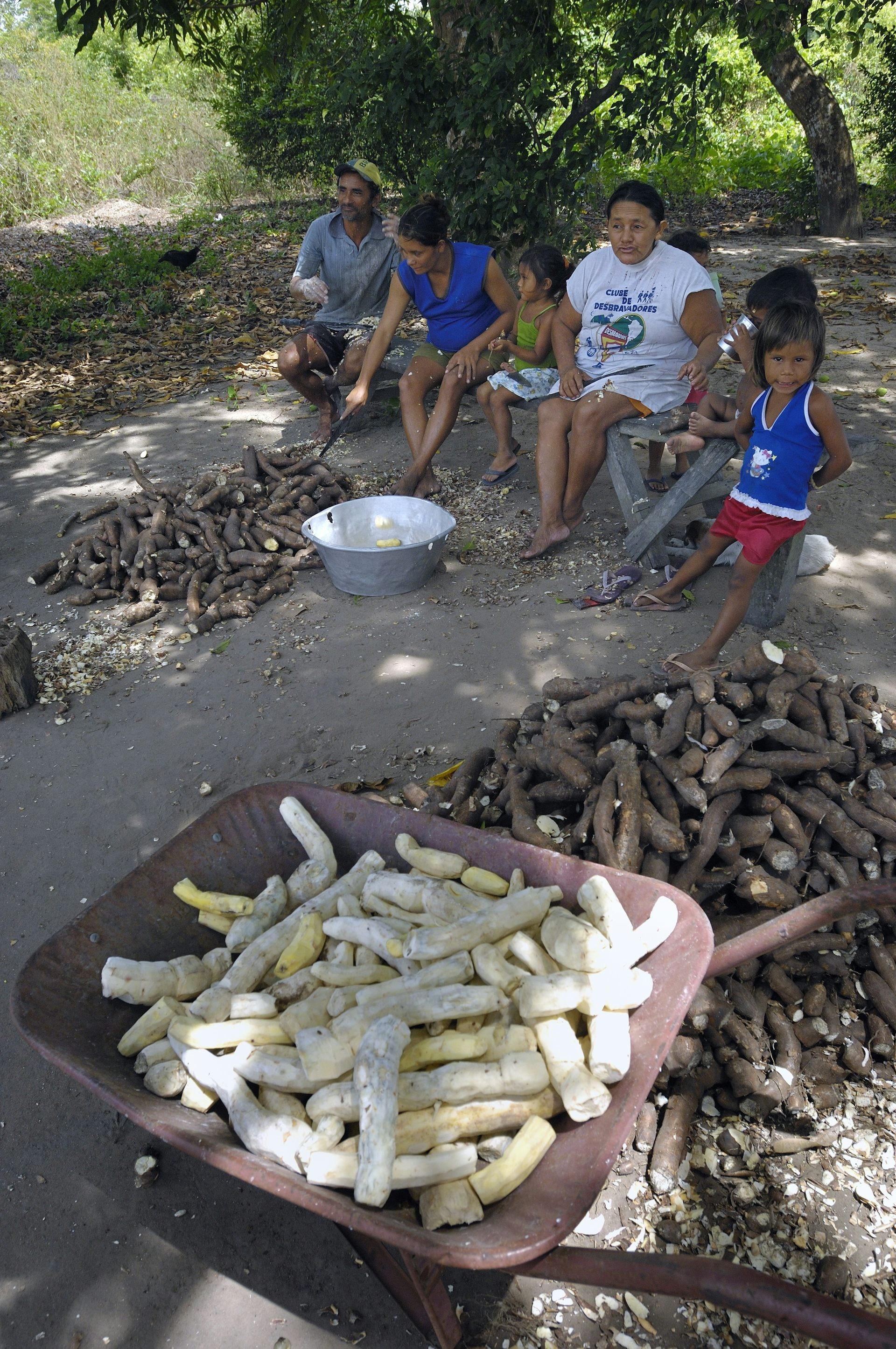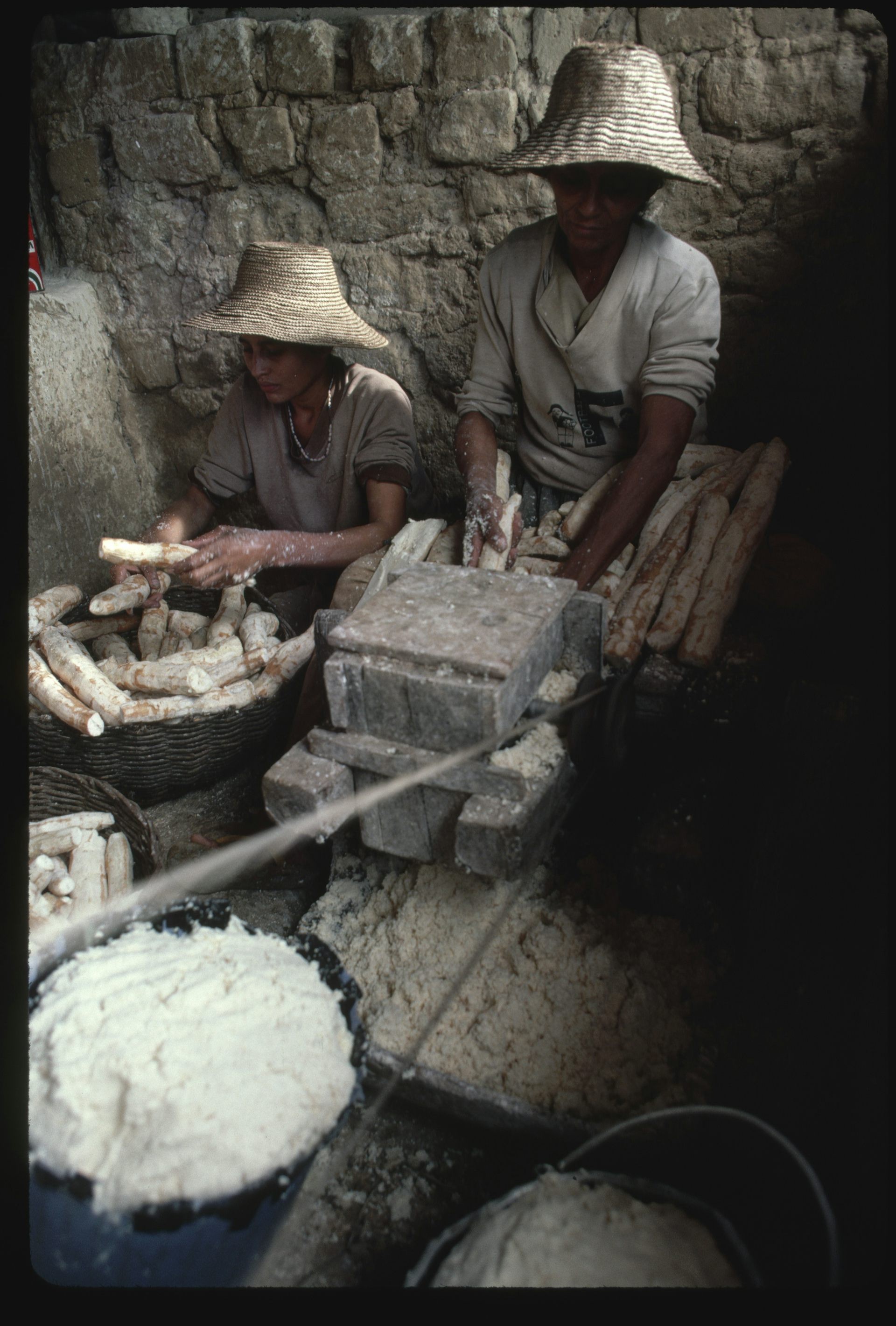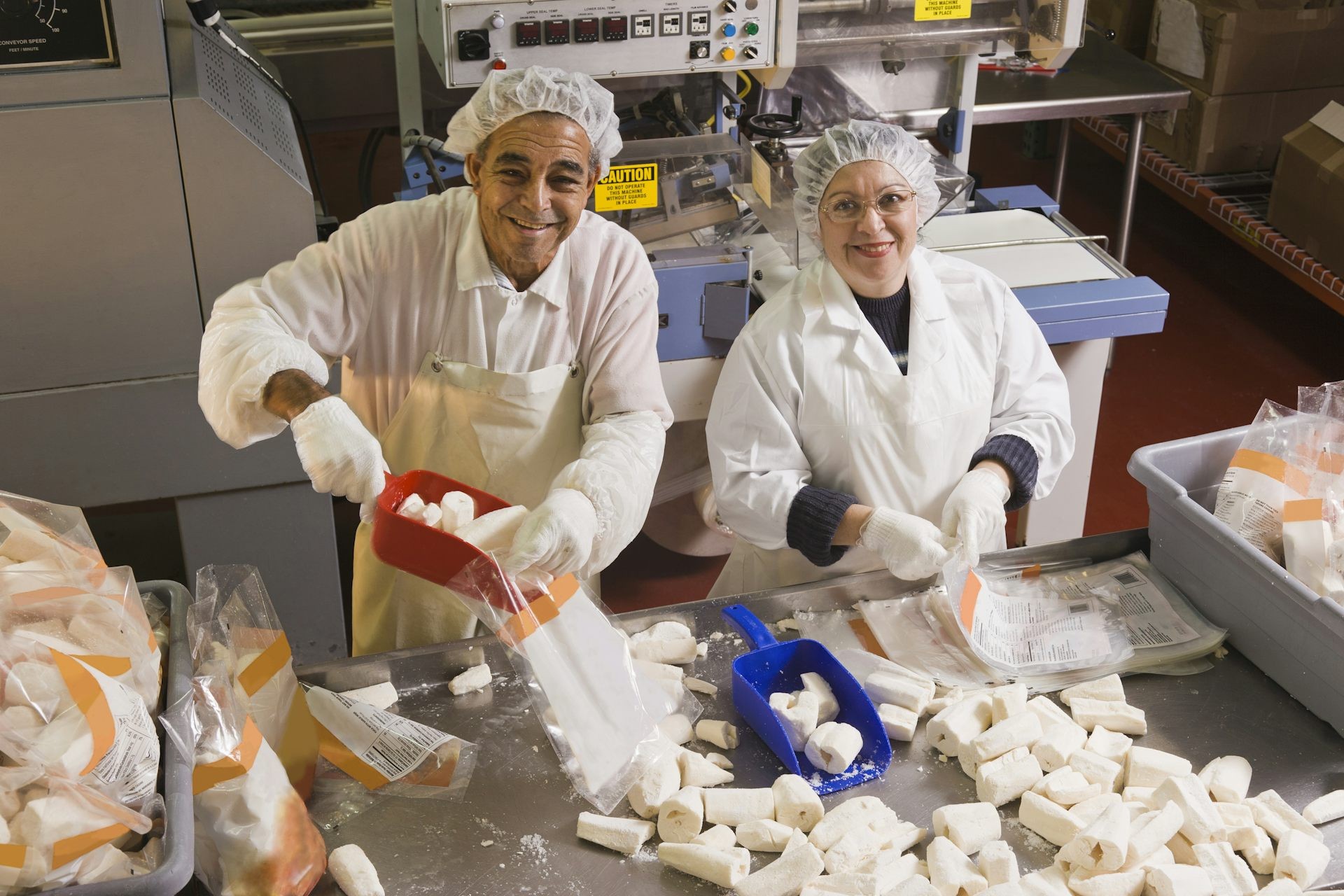What Is Cassava? Cassava, also known as yuca or manioc, is a starchy root vegetable gaining popularity worldwide, and WHAT.EDU.VN is here to provide you with all the information you need about it. Discover its origin, nutritional value, and diverse uses. Explore cassava’s potential as a sustainable food source, cassava nutrition, and cassava recipes.
1. What Is Cassava and Where Does It Come From?
Cassava ( Manihot esculenta ) is a root vegetable native to South America, specifically the Amazon basin in Brazil. It has been cultivated for thousands of years and is a staple food for millions of people in tropical and subtropical regions around the world. It’s known for its resilience and ability to grow in poor soils and drought conditions. Cassava plant is a key source of nutrition throughout the tropics.
2. What Are the Different Names for Cassava?
Cassava goes by several names depending on the region:
- Yuca: This is a common name, especially in Latin America and the United States.
- Manioc: Another frequently used name, particularly in French-speaking countries and some parts of South America.
- Tapioca: Technically, tapioca is the starch extracted from the cassava root. However, sometimes the term is loosely used to refer to cassava itself.
- Mandioca: Used in Brazil and other Portuguese-speaking regions.
- Kappa: Known by this name in some regions of India, especially Kerala.
3. What Is the Nutritional Value of Cassava?
Cassava is a good source of carbohydrates, primarily starch. It also contains some vitamins and minerals. Here’s a general breakdown of the nutritional content per 100 grams of cassava root:
- Calories: 160
- Carbohydrates: 38 grams
- Fiber: 2 grams
- Protein: 1 gram
- Fat: 0.3 grams
- Vitamin C: 20% of the Daily Value (DV)
- Thiamin: 7% of the DV
- Riboflavin: 3% of the DV
- Niacin: 3% of the DV
- Potassium: 4% of the DV
- Magnesium: 3% of the DV
- Manganese: 8% of the DV
- Copper: 12% of the DV
- Iron: 1% of the DV
It’s important to note that the nutritional content can vary depending on the variety of cassava and how it is processed.
4. Is Cassava Poisonous? What Makes It Safe to Eat?
Raw cassava contains cyanogenic glycosides, which can release cyanide when consumed. This is why it’s crucial to properly prepare cassava before eating it. There are two main types of cassava:
- Sweet Cassava: Contains lower levels of cyanogenic glycosides and requires less processing.
- Bitter Cassava: Contains higher levels of cyanogenic glycosides and requires more extensive processing to make it safe for consumption.
The traditional methods of processing cassava involve peeling, grating, soaking, fermenting, and cooking. These processes reduce the cyanide content to safe levels. Modern methods may also include drying and milling.
5. How Is Cassava Processed to Remove Cyanide?
Traditional methods of cassava processing are highly effective in reducing cyanide levels. Here are some common techniques:
- Peeling: Removing the outer skin helps to reduce cyanide content.
- Grating: Grating the cassava root increases the surface area, allowing for more cyanide to be released during subsequent steps.
- Soaking: Soaking the grated cassava in water for several hours or days helps to leach out cyanide.
- Fermentation: Fermenting the cassava pulp further reduces cyanide levels.
- Cooking: Boiling, baking, or frying cassava breaks down the remaining cyanogenic glycosides.
- Drying: Sun-drying the cassava pulp also helps to eliminate cyanide.
The specific processing methods used depend on the type of cassava (sweet or bitter) and the local culinary traditions.
6. What Are the Different Ways to Cook and Eat Cassava?
Cassava can be cooked and eaten in many different ways. Here are some popular preparations:
- Boiled: Boiled cassava is a simple and common way to prepare it. It can be eaten as a side dish or used in soups and stews.
- Fried: Cassava fries are a delicious alternative to potato fries. They can be deep-fried or pan-fried.
- Baked: Baked cassava is a healthier option. It can be seasoned with herbs and spices.
- Mashed: Mashed cassava is similar to mashed potatoes. It can be served as a side dish or used as a filling for pastries.
- Cassava Flour: Cassava flour is a gluten-free alternative to wheat flour. It can be used to make bread, cakes, and other baked goods.
- Tapioca: Tapioca is the starch extracted from cassava. It is used to make pudding, boba tea, and other desserts.
- Fufu: Fufu is a starchy dough made from cassava flour. It is a staple food in many West African countries.
- Garri: Garri is a granular flour made from fermented cassava. It is a popular food in West Africa and is often eaten with soup or stew.
- Cassava chips: A popular snack made by slicing cassava thinly and frying or baking it until crisp.
7. What Are the Benefits of Eating Cassava?
Cassava offers several potential health benefits:
- Good Source of Energy: Cassava is high in carbohydrates, providing a good source of energy.
- Gluten-Free: Cassava flour is a gluten-free alternative to wheat flour, making it suitable for people with celiac disease or gluten intolerance.
- Resistant Starch: Cassava contains resistant starch, which can improve gut health and blood sugar control.
- Versatile: Cassava can be cooked and eaten in many different ways, making it a versatile ingredient in various cuisines.
- Sustainable Crop: Cassava is a resilient crop that can grow in poor soils and drought conditions, making it a sustainable food source.
- Rich in Vitamin C: Contributes to immune function, skin health, and antioxidant protection.
- Contains Manganese: Supports bone health, metabolism, and antioxidant defenses.
- Source of Copper: Essential for energy production, iron metabolism, and nerve function.
8. What Are the Risks of Eating Cassava?
The main risk associated with eating cassava is cyanide poisoning if it is not properly processed. Symptoms of cyanide poisoning can include:
- Nausea
- Vomiting
- Headache
- Dizziness
- Weakness
- Difficulty breathing
- Seizures
- Coma
In severe cases, cyanide poisoning can be fatal.
It’s important to purchase cassava from reputable sources and to follow proper preparation methods to minimize the risk of cyanide poisoning. People with certain medical conditions, such as those with impaired liver or kidney function, may be more susceptible to cyanide poisoning and should consult with a healthcare professional before consuming cassava.
9. Can Cassava Be Used for Industrial Purposes?
Yes, cassava has various industrial applications:
- Starch Production: Cassava is a major source of starch used in various industries, including food processing, textiles, paper, and adhesives.
- Biofuel Production: Cassava can be fermented to produce ethanol, a biofuel that can be used as an alternative to gasoline.
- Animal Feed: Cassava chips and pellets are used as animal feed, particularly for pigs and poultry.
- Biodegradable Plastics: Cassava starch can be used to produce biodegradable plastics, offering a sustainable alternative to conventional plastics.
- Pharmaceuticals: Cassava starch is used as a binder and filler in pharmaceutical tablets and capsules.
10. How Is Cassava Contributing to Global Food Security?
Cassava plays a significant role in global food security due to its:
- Resilience: It can tolerate poor soils, drought, and pests, making it a reliable crop in challenging environments.
- High Yields: Cassava can produce high yields compared to other staple crops.
- Versatility: It can be used in a variety of food products and industrial applications, increasing its value and demand.
- Availability: It is readily available in many tropical and subtropical regions, making it an accessible food source for local populations.
- Climate Change Adaptation: As climate change impacts agricultural production, cassava’s resilience makes it an important crop for ensuring food security in vulnerable regions.
11. What Is the Difference Between Cassava and Tapioca?
Cassava and tapioca are related but distinct:
- Cassava: The whole root vegetable (Manihot esculenta). It is processed to remove toxins and then used in various dishes.
- Tapioca: The starch extracted from the cassava root. This starch is processed into pearls, flour, or flakes and used in desserts, beverages, and as a thickening agent.
In short, cassava is the plant, and tapioca is one of the products derived from it.
12. What Is the Difference Between Cassava and Taro?
Cassava and taro are both root vegetables, but they are different species with distinct characteristics:
| Feature | Cassava (Manihot esculenta) | Taro (Colocasia esculenta) |
|---|---|---|
| Origin | South America | Southeast Asia |
| Taste | Mild, slightly sweet | Nutty, earthy |
| Texture | Firm | Soft, sometimes slimy |
| Cyanide Content | High (requires processing) | Lower (but still present) |
| Uses | Flour, fries, boiled, chips | Poi, soups, stews |



Both require cooking before consumption, but cassava generally needs more extensive processing to remove toxins.
13. Where Can I Buy Cassava?
Cassava can be found in:
- International Grocery Stores: Stores specializing in Latin American, African, or Asian foods are likely to carry fresh or frozen cassava.
- Farmers’ Markets: Some farmers’ markets, especially in warmer climates, may sell fresh cassava.
- Online Retailers: Online stores may offer cassava flour, tapioca products, and sometimes fresh cassava.
When buying fresh cassava, look for firm, unblemished roots without any soft spots or signs of decay.
14. What Are Some Popular Cassava Recipes?
Here are a few popular cassava recipes to get you started:
- Cassava Fries: Cut cassava into fry shapes, boil briefly, and then deep-fry or bake until golden brown.
- Cassava Chips: Thinly slice cassava, season, and bake or fry until crispy.
- Cassava Cake: A sweet cake made with grated cassava, coconut milk, and sugar.
- Bobba Tea: A popular beverage made with tapioca pearls.
- Cassava with Garlic Sauce: Boiled cassava served with a flavorful garlic sauce.
- Cassava Bread: A gluten-free bread made with cassava flour.
15. Is Cassava Sustainable?
Yes, cassava is considered a sustainable crop due to several factors:
- Low Input Requirements: It can grow in poor soils with minimal fertilizer or pesticides.
- Drought Tolerance: It can withstand dry conditions, making it suitable for regions with limited rainfall.
- Carbon Sequestration: Cassava plants can sequester carbon dioxide from the atmosphere, helping to mitigate climate change.
- Reduced Food Waste: Cassava can be stored in the ground for extended periods, reducing post-harvest losses.
- Crop Diversification: Incorporating cassava into farming systems can increase biodiversity and resilience.
16. What Is the Future of Cassava?
Cassava is poised to play an increasingly important role in global food security and sustainable agriculture. Ongoing research and development efforts are focused on:
- Improving Yields: Breeding new varieties with higher yields and improved nutritional content.
- Enhancing Processing Methods: Developing more efficient and cost-effective processing techniques to reduce cyanide levels and increase shelf life.
- Expanding Industrial Applications: Exploring new uses for cassava in biofuel production, bioplastics, and other industries.
- Promoting Climate Resilience: Developing cassava varieties that are more resistant to climate change impacts, such as drought and heat stress.
- Supporting Smallholder Farmers: Providing training and resources to help smallholder farmers increase cassava production and improve their livelihoods.
17. Are there any cultural or traditional uses of cassava?
Yes, cassava holds significant cultural and traditional importance in many communities around the world:
- Indigenous Traditions: In South America, cassava is deeply rooted in indigenous cultures, with traditional methods of cultivation, processing, and consumption passed down through generations.
- Religious Ceremonies: In some cultures, cassava is used in religious ceremonies and rituals.
- Festivals: Cassava festivals are held in various regions to celebrate the harvest and cultural significance of the crop.
- Traditional Medicine: In some traditional medicine systems, cassava is used to treat various ailments.
- Culinary Heritage: Cassava dishes are an integral part of the culinary heritage of many countries, with unique recipes and cooking techniques.
- Social Gatherings: Cassava-based foods are often shared during social gatherings and celebrations, fostering community bonds.
18. What are the environmental impacts of cassava production?
While cassava is generally considered a sustainable crop, there are some potential environmental impacts associated with its production:
- Deforestation: In some regions, cassava cultivation can contribute to deforestation as land is cleared for planting.
- Soil Erosion: Intensive cassava farming can lead to soil erosion, especially on sloping lands.
- Water Use: Cassava production can require significant amounts of water, particularly in irrigated systems.
- Pesticide Use: While cassava is relatively pest-resistant, pesticide use may be necessary in some cases, which can have negative impacts on the environment and human health.
- Monoculture: Continuous cassava cultivation can lead to soil nutrient depletion and increased vulnerability to pests and diseases.
Sustainable cassava production practices, such as crop rotation, intercropping, and conservation tillage, can help to mitigate these environmental impacts.
19. What are the challenges facing the cassava industry?
The cassava industry faces several challenges:
- Cyanide Toxicity: The presence of cyanogenic glycosides in cassava requires proper processing to ensure food safety.
- Pest and Disease Management: Cassava is susceptible to various pests and diseases, which can reduce yields and quality.
- Post-Harvest Losses: Cassava roots are perishable and can deteriorate quickly after harvest, leading to significant post-harvest losses.
- Market Access: Smallholder farmers often lack access to markets and face challenges in selling their cassava at fair prices.
- Infrastructure Deficiencies: Inadequate infrastructure, such as roads, storage facilities, and processing plants, can hinder the development of the cassava industry.
- Climate Change Impacts: Climate change impacts, such as drought and heat stress, can negatively affect cassava production.
- Lack of Investment: Insufficient investment in research, development, and infrastructure can limit the growth and competitiveness of the cassava industry.
20. Where can I find more information about cassava?
You can find more information about cassava from various sources:
- WHAT.EDU.VN: Of course, our website is a great place to start for reliable and accessible information.
- Research Institutions: Organizations like the International Center for Tropical Agriculture (CIAT) conduct research on cassava and provide valuable information.
- Government Agencies: Agricultural agencies in countries where cassava is a staple crop often have information and resources available.
- Academic Journals: Scientific journals publish research articles on various aspects of cassava, including its cultivation, processing, and nutritional value.
- Books: There are many books available on cassava, covering topics such as its history, botany, and culinary uses.
- Online Databases: Databases like the Food and Agriculture Organization of the United Nations (FAO) provide statistics and information on cassava production and trade.
- Extension Services: Local agricultural extension services can provide farmers with practical advice and training on cassava cultivation.
Cassava offers a wealth of possibilities as a food source, industrial material, and sustainable crop. From its rich history to its promising future, cassava continues to be a vital resource for communities around the world.
Have more questions about cassava or other topics? Don’t hesitate to ask on WHAT.EDU.VN. Our community of experts is ready to provide you with free, accurate, and helpful answers. Contact us at 888 Question City Plaza, Seattle, WA 98101, United States, or via Whatsapp: +1 (206) 555-7890. Visit our website at what.edu.vn to submit your questions and get the answers you need!